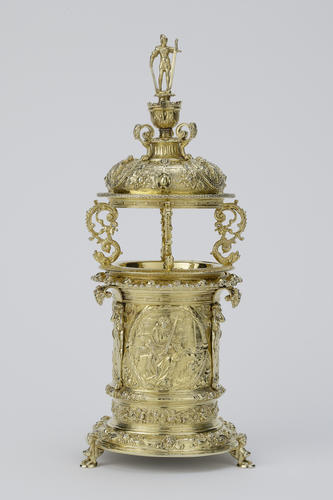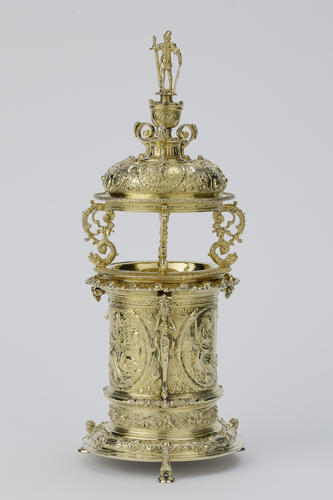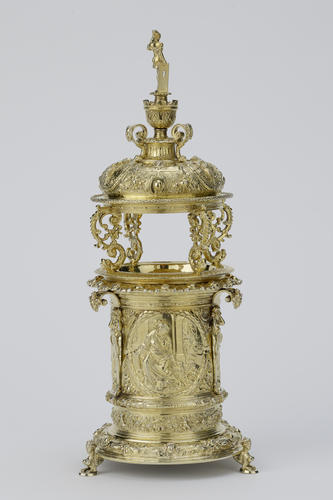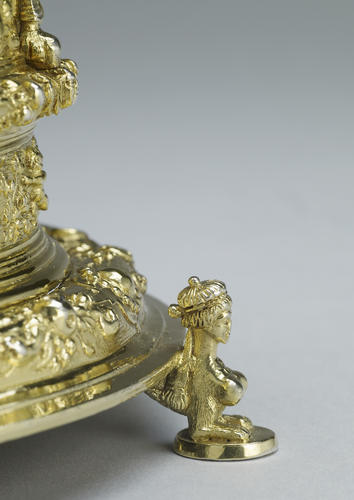-
1 of 253523 objects
Standing salt 1572-73
Silver gilt | 29.2 cm (excluding fittings) | RCIN 31773










-
Cylindrical salt on cast and chased base supported by three sphinx feet; cast band of infants at base, with three oval cartouches portraying the three virtues above, named beneath. Domed cover held up by three later scroll supports with an armed warrior figure.
Ceremonial standing salts, often of elaborate and intricate construction, were used on royal and aristocratic dining tables from the medieval period into the eighteenth century to mark the status of those dining by reference to their position at table in relation to the salt (i.e. 'above' or 'below'). This piece is normally displayed with the banqueting plate and coronation regalia in the Tower of London. Its association with Queen Elizabeth I appears to be a nineteenth-century invention and was probably suggested by the Tudor rose inside the cover. It is not identifiable in any royal inventories or Jewel House records until the 1680s. Charles II's cypher engraved under one of the feet suggests that it was acquired around 1660, probably from Sir Robert Vyner, who held the warrant to replace the royal plate and crown jewels sold or melted during the Interregnum (1649-60). With the exception of this salt and two German tankards, all the replacements were new made in London.
Of the salt's earlier history nothing is known. It is struck with the maker's mark attributed to Affabel Partridge (goldsmith to Queen Elizabeth from about 1558 to 1576), whose work is characterised by its exceptional quality and lavish decoration. It is closely related to a salt belonging to the Vintners' Company, with the same maker's mark and dated 1569-70. Both incorporate panels depicting the Virtues after plaquettes by the German sculptor Peter Flötner (master 1522). The domed cover is cast with panels depicting Ceres, Lucretia and Cleopatra. This originally sat directly upon the main body of the salt; in around 1610 an open ring frame with scrolled brackets was introduced, converting the cover to a canopy raised above the cellar bowl.
Queen Elizabeth's Salt appears to have been added to the set known as the St George's Salts following the loss of one of their number after 1688. The ceremonial use of the St George's Salts remains unclear. They were perhaps used at the lavish banquets held in Westminster Hall following coronation ceremonies in Westminster Abbey. It has also been suggested that they were originally part of a larger set of salts ordered for the banquet of the Garter Knights held before Charles II's coronation in 1661 and used at subsequent Garter banquets at Windsor Castle.
Hallmarks for London, 1572-3 and maker's mark attributed to Affabel Partridge.
Catalogue entry from Royal Treasures, A Golden Jubilee Celebration, London 2002Provenance
Probably supplied to Charles II by Sir Robert Vyner, c.1660.
-
Medium and techniques
Silver gilt
Measurements
29.2 cm (excluding fittings)
35.0 cm (with fittings)
1390.0 g (Weight) (excluding fittings)
1600.0 g (Weight) (with fittings)
Alternative title(s)
Queen Elizabeth's Salt